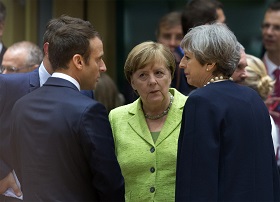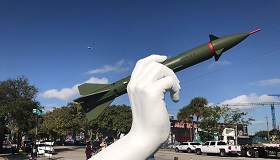The number of nuclear weapon states, their respective arsenals, and transatlantic nuclear arrangements make Europe one of the most “nuclearized” continents. Luckily, even when the total warhead numbers were even higher, nuclear use had been avoided – although the threat remains real. Relations between Russia and NATO currently seem somewhat stabilized, although on a degraded level, but the crisis around the INF Treaty may easily become fuel for future conflicts.
Armed Forces of all nations in Europe have enough lethal tools to burn the continent to ashes, even without those currently covered by the INF Treaty. However, if the Treaty dies, the threat level may become even higher. More weapons with shorter flight times do not help to feel safe, putting pressure on the decision-making process, so escalation becomes more probable – and rapid.
Even if there would be no intermediate-range nuclear forces with conventional-only intermediate and shorter-range missiles fielded, any conflict between Russian and NATO forces would become nuclear soon enough. This will happen not because of some cunning “escalate-to-deescalate” strategies US partners believe in. The escalation itself will lead to catastrophic consequences.
Europe as a nuclear battlefield
The number of nuclear weapon states, their respective arsenals, and transatlantic nuclear arrangements make Europe one of the most “nuclearized” continents. Luckily, even when the total warhead numbers were even higher, nuclear use had been avoided – although the threat remains real. Relations between Russia and NATO currently seem somewhat stabilized, although on a degraded level, but the crisis around the INF Treaty may easily become fuel for future conflicts.
Armed Forces of all nations in Europe have enough lethal tools to burn the continent to ashes, even without those currently covered by the INF Treaty. However, if the Treaty dies, the threat level may become even higher. More weapons with shorter flight times do not help to feel safe, putting pressure on the decision-making process, so escalation becomes more probable – and rapid.
Even if there would be no intermediate-range nuclear forces with conventional-only intermediate and shorter-range missiles fielded, any conflict between Russian and NATO forces would become nuclear soon enough. This will happen not because of some cunning “escalate-to-deescalate” strategies US partners believe in. The escalation itself will lead to catastrophic consequences.
INF Treaty challenge
The INF Treaty seems to be going full speed towards the burial grounds. Of course, the suspension is not total destruction of this regime, but the events before and after announcements made by the parties in the first days of February make it almost impossible to reverse the trend. The US insists that only verifiable destruction of the Russian 9M729 (SSC-8) ground-launched cruise missile (GLCM) and associated infrastructure will save the Treaty. Russian Ministry of Defense, in turn, asked the American side to destroy Aegis Ashore sites, as well as missile targets and long-range strike unmanned aerial vehicles (UAVs) [1]. The basis for this new Russian move could have been an idea about the possibility of the US side re-thinking their attitude towards the “destruction” ultimatum itself, but the official reaction from the US mission to NATO hints that there will be no progress this way [2]. That last “initiative” was a rather new development, as previously Russian Ministry of Foreign Affairs offered some degree of mutual transparency to address alleged Treaty violations and find solutions. Saving the Treaty remains the announced task for Russian diplomacy.
It is noteworthy that the US did not publicly present any information to support their allegations that 9M729 indeed violates the Treaty. On the opposite side, Russia provided some information on the missile design and capabilities, the tests at Kapustin Yar missile range, and even had shown 9M729 launch canister and road-mobile launcher. Unfortunately, it was not enough and probably too late for a real shift in the public opinion and the views of European officials.
Now we have two adversaries with suspended Treaty obligations and announced plans to develop new ground-launched intermediate-range missiles. The US claims they have to counter Russian deployments of 9M279 missile, that allegedly threatens European allies. Russia, in turn, “mirrors” US actions and starts developing “Land-based Kalibr” and intermediate-range hypersonic missile. Given the capabilities of two countries’ defense industry and the rather long period of the INF Treaty being in limbo, we can expect first test-launches well before the final withdrawal. However, there should have been a reason for the US to announce suspension, other than “pressure on Russia.”
One of the worst scenarios that may be unleashed rather soon is the US eventually putting Tomahawk land-attack missiles in the Aegis Ashore launch tubes. It may destroy the credibility of the Euro-Atlantic policy-makers. Despite popular belief, Russian officials will not be happy with that – after all, parties have to cooperate on many issues, and to avoid direct clashes, so a responsible partner is a necessity.
Landmark events may occur in other state-parties to the INF Treaty as well. The US intermediate-range missiles in Ukraine and Russian ones in Belarus seem highly improbable, but both countries are not new in this game. Ukraine would like to have missiles with ranges enough to threaten Moscow, and Grom-2 SRBM prototype (funded by Saudi Arabia) is the obvious candidate for range extension. Belarus also has some capabilities. Currently available missiles for Polonez MLRS lack the characteristics to consider them a basis for systems covered by the INF, but there is a chance that something new may be developed in the future – or procured in China as it was the case with Polonez missiles themselves. Unlike Ukraine, Belarus has a well-known production of chasses for missile launchers, which is a rather valuable asset.
There is a conceptual problem with the INF Treaty in terms of the weapon types covered by it. Even though widely accepted acronym stands for “nuclear forces,” the original name was about “missiles” without specifying the payload. Currently, the US underlines that they have no intention in deploying nuclear-tipped missiles in Europe (and probably in Asia as well). There were no official comments by the Russian side on the payload of the new intermediate-range missiles, but the general assumption is that almost anything in Russian arsenal that is bigger than an anti-tank guided missile has a nuclear warhead as an option. Those warheads are presumably locked in “central storages,” but the ambiguity is present. What makes this “equation” even harder to solve is the fact that precision-guided munitions are rapidly approaching the capabilities of nuclear weapons, at least on sub-strategic levels. At the same time, the US pursues low-yield nuclear warheads, thus adding to the ambiguity as well.
The worst part of this nuclear-conventional dynamics concerning European theater and the weapons present and announced is that under any scenario when the missiles start flying all-out nuclear war seems like a most probable final stage.
Broader security arrangements
Is there a way to solve the crisis? NATO countries rallied behind the US allegations against Russia, and do not support the Russian questions about the US compliance with the INF Treaty. However, the desire to save the Treaty remains, and even calls to the US to offer something to Russia in exchange to non-deployment of 9M729 GLCM in Europe can be heard. Still, the situation remains deadlocked.
Overall, the story around the INF Treaty looks like a symptom, rather than a problem in itself. The symptom of a broader degradation of arms control and communication skills both sides of the Atlantic Ocean. Russia, the US, Germany, NATO, CSTO, and other actors have conflicting narratives around the INF Treaty. To make things worse, US and Russian decisions to suspend the Treaty obligations make other countries joining the regime next to impossible, despite the best intentions of other concerned actors.
However, there is one real prospect – Russian, European and the US officials engage in the dialogue, and there’s hope that even if they fail even to “agree to disagree,” they will again learn how to discuss such issues.
The positive sign was Russia announcing self-restraint in terms of INF systems deployment in any region of the world unless similar US systems appear there [3]. Of course, given the US belief in violating nature of already deployed 9M729 GLCM, the situation may get ugly soon enough, but there’s still a chance for a managed dissolution of the INF Treaty that limits its damage.
One of the options would be to achieve some regional “non-deployment pact,” and it can be discussed either within Russia-NATO Council or even directly between the EU and Russia (or CSTO, which may be harder for Europe to agree to). A formal agreement with verification measures should be put in place eventually, but this is a very challenging task. Unilateral non-deployment statements and announcements of intent to achieve broader security architecture tailored for the current state of affairs in Europe may be good enough for a start. It is critical to reach out towards relevant actors beforehand and understand the limits of their goodwill, and redlines as well, for the success of even such a limited solution. These measures and actions may help to calm the conflict and serve as a “crutch” for a struggling Russia-US arms control.
Europe is our collective legacy, and while we tried to ruin our civilization several times, there is hope that we learned enough. Now Europe must become a source of innovative approaches towards nuclear weapons policies that will gradually help to achieve a stable global nuclear order, reducing the chances for nuclear warfighting anywhere in the world.
First published in Welt Trends
1. “The Russian Defence Ministry informs the US party on strict compliance with the INF Treaty requirements”, Ministry of Defence of the Russian Federation, 07.02.2019, http://eng.mil.ru/en/news_page/country/more.htm?id=12216391@egNews
2. “The United States Remains in Compliance with the INF Treaty”, US Mission to NATO, 08.02.2019, https://nato.usmission.gov/press-release-the-united-states-remains-in-compliance-with-the-inf-treaty/
3. “We proceed from the premise that Russia will not deploy intermediate-range or shorter-range weapons, if we develop weapons of this kind – neither in Europe nor anywhere else until US weapons of this kind are deployed to the corresponding regions of the world.”, Vladimir
Putin, the President of the Russian Federation. Meeting with Sergei Lavrov and Sergei Shoigu, 02.02.2019, http://en.kremlin.ru/events/president/news/59763







